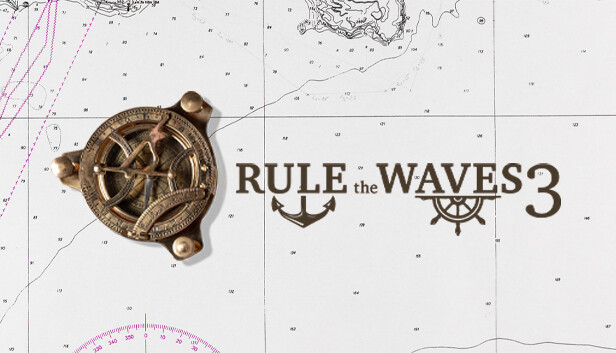Naval Procurement is researching new technologies, designing new things based off of that, and then building them. It’s a tough task, especially when you have a limited budget, research, and have to manage an entire navy.
CH 0: Game Setup
 After you select a start date and then a country, you will come upon this screen. I’ve circled in red the important settings that will affect your naval procurement throughout the game.
After you select a start date and then a country, you will come upon this screen. I’ve circled in red the important settings that will affect your naval procurement throughout the game.
Firstly, fleet size: Fleet size determines the budgets of every country in game, including yours. If you choose Very Large fleet size, for example then every country would recieve an increased budget to accommodate more ships. However, this scales proportionally! This means that a poorer country like Italy or Japan will still have a smaller budget in comparison to a country like the United Kingdom. Everyone will be able to afford more ships, but whether you’re playing with Small, Medium, or Large fleet size, the proportion of resources will remain the same.
Secondly, you can tick “Historical Resources” on or off. If you leave this off, poorer countries will have a much larger economy than they had in real life. This evens out the playing field quite a bit, bringing poorer powers like China or Spain closer to a powerhouse like the United Kingdom. Unlike fleet size, this is NOT proportional- the economically powerful countries like USA will not receive a larger economy, but Austria Hungary would.
Next is research rate. This determines how fast or slow research is performed by all of the countries in game, as a measure of percentage. 90% research rate would be 10% slower than the default. This number cannot be raised above 100% (default).
Research variation determines the year technologies can be researched. If it is set to “none”, technologies will only start being reserached in the exact year they were discovered in real life. If you set it to slight, it might change by 1-2 years, while using considerable means that technologies could be discovered 6 years early/late, and differ greatly in how effective the invention actually is.
Finally, you can choose to enable “slow aircraft development”. This will set back Aircraft research only for all countries for years. So if you want to extend the age before planes became the king of the seas that is an option.
CH 1: Setting Doctrinal Priority
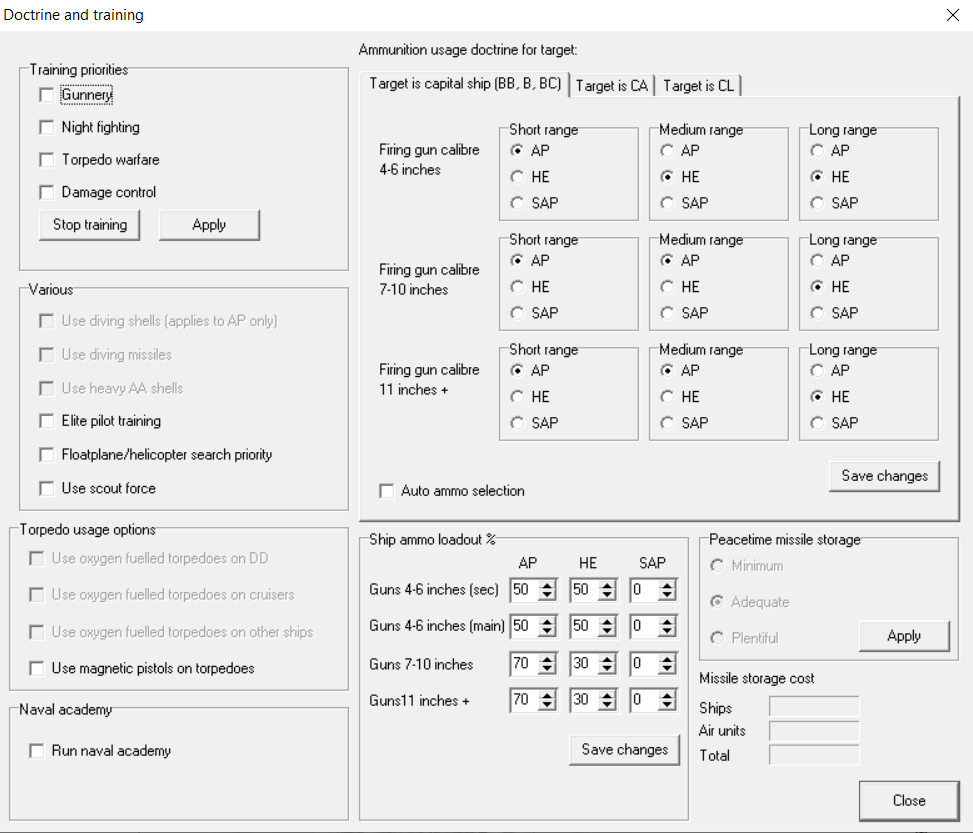 This is the doctrine screen. You can give extra training to sailors in certain tactics in the top left, increasing maintenance cost and only taking effect 12 months after you started that training, if you check gunnery then your sailors will have a bonus to accuracy once the training completes. Note that the moment you stop paying for this extra training, the benefits dissapear too. You can adjust various other items below and change torpedo usage. For example, oxygen fuelled torpedos do significantly more damage, but if one of your ships using them is hit in the torpedo mount/storage, it’ll suffer far more damage than normal.
This is the doctrine screen. You can give extra training to sailors in certain tactics in the top left, increasing maintenance cost and only taking effect 12 months after you started that training, if you check gunnery then your sailors will have a bonus to accuracy once the training completes. Note that the moment you stop paying for this extra training, the benefits dissapear too. You can adjust various other items below and change torpedo usage. For example, oxygen fuelled torpedos do significantly more damage, but if one of your ships using them is hit in the torpedo mount/storage, it’ll suffer far more damage than normal.
On the right you’ve got your ammo doctrine. AP shells tend to have more penetration power at close range, but at long range you may have trouble and would want to use HE shells. It’s all up to you to decide the ammo usage doctrine, aswell as what percent of the shells kept are AP vs HE. Once you unlock SAP ammo, you can use that- it’s kind of a halfway between the two.
CH 2: Research
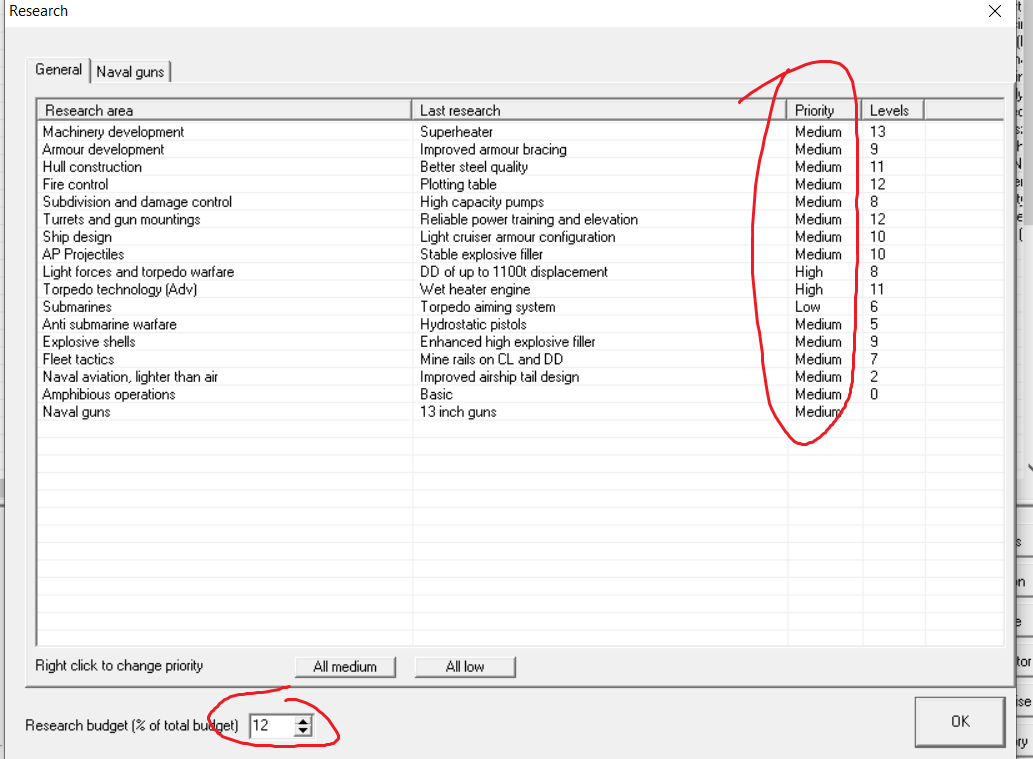 You will have to set your budget to the desired amount (max 12%) and then think about what you want your researchers to look into. Do you want larger, more powerful guns? Then put naval gun research on high priority. Not interested in machinery developments? Put it on low. Remember that every research topic here takes a portion of the budget: if you set every single topic to “high” priority, then nothing is being prioritized. Everything is being researched at the same, equal rate.
You will have to set your budget to the desired amount (max 12%) and then think about what you want your researchers to look into. Do you want larger, more powerful guns? Then put naval gun research on high priority. Not interested in machinery developments? Put it on low. Remember that every research topic here takes a portion of the budget: if you set every single topic to “high” priority, then nothing is being prioritized. Everything is being researched at the same, equal rate.
In this case, it was 1915. I was playing Austria Hungary with a US ally, and fighting a war against the UK. Not a scenario I wanted to be in, but one I was prepared for. Up to this point I focused efforts into smaller ships, since most countries I would go against had larger economies for capital ships than I had. I would build battleships with a lot of armor and OK speed, to soak up fire for my DD’s to get in there and torpedo the enemy ships. Also, I don’t like using submarines, so from the very beginning I put it on low research priority.
CH 3: Staggered Production
Staggered production is essential to any procurement program. What this means is that, instead of designing a new ship of every type, every year, and rebuilding the entire fleet every year, you space it out over a longer period of time. Design and build a run of DD’s this year. Design and build a run of BB’s the next. Make a new CL a year after that. But why?
It is essential to stagger production, so that you can minimize financial and dock capacity costs, while maximizing the benefits of your research, and countering obsolescence. If you make a new CL every 2 years, then there will be only minor technology benefits, yet you are still paying 100% for the price of a new ship. Instead, make a CL, then a BB, then a DD, then a CA, then at last looping back to a new CL design. You can have whatever order suits you best, whatever you choose, it is important to spread out ships of the same role so that you can get more years of research in every hull.
With regards to obsolescence, let’s say I built 5 BB’s 1 year from now. That’s extremely expensive. 11 years from now, I will have to replace 6, old, aging and difficult to use BB’s. This is a problem, yet again, and it repeats in cycles. So while not only staggering the role of ship you build, you also have to stagger the AMOUNT of ships in each role. Instead, I should build 2 BB’s 1 year from now, then 3 BB’s 6 years from now. That way, 11 year from now, I only have to replace 40% of my BB’s instead of all of them. Instead of building 8 CL’s this year, I design and build 4 this year, then design a new class 5 years from now and build 4 of those. I’ll still have 8 CL’s total, but again, I won’t have to replace every single ship at once, significantly reducing costs. Your production will look like a ladder, something like this.
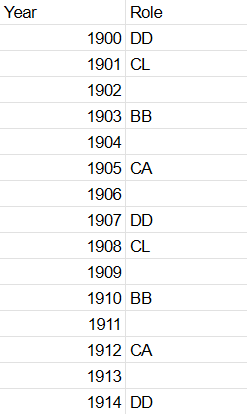
To build submarines, they are built separately from the ship design process, using the “Build Sub” button below “Build Ship”. You cannot design a special submarine, they are abstracted into various classes (coastal submarine, medium range, etc). You can turn on auto-build submarines if you want.
CH 4: Ship Designer, Hull
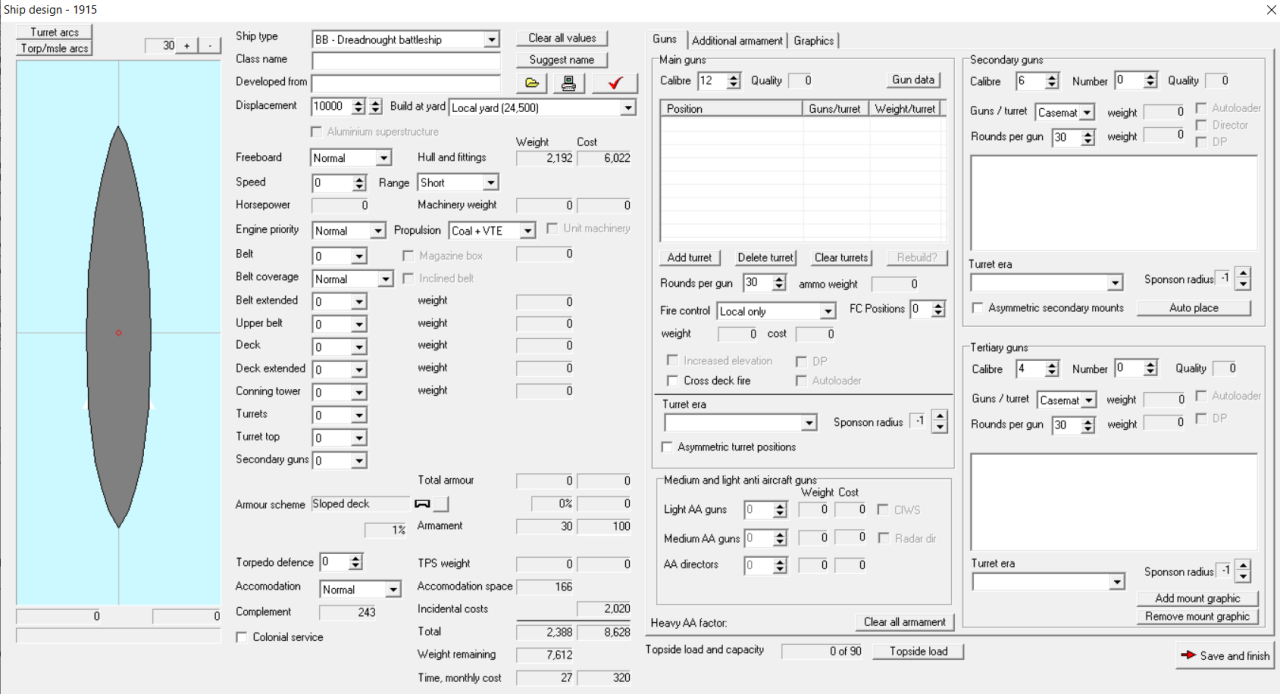 Here is our glorious ship editor. The visual editor is a bit complicated to use, I would recommend against it unless you want to go through the manual and figure out how to work it. Instead, select the role of ship you want in the top left, select whether you will build it at a local or foreign dockyard, and then hit the computer button and confirm that you want it to make a design.
Here is our glorious ship editor. The visual editor is a bit complicated to use, I would recommend against it unless you want to go through the manual and figure out how to work it. Instead, select the role of ship you want in the top left, select whether you will build it at a local or foreign dockyard, and then hit the computer button and confirm that you want it to make a design.
If you build things at a foreign dockyard, you gain access to that nation’s shipbuilding technology and their dock size. But it’s not all sunshine and rainbows. If you go to war with them and the ship is still building… well… guess who paid for part of a ship that the enemy now possesses? It doesn’t contribute to your country’s local shipbuilding economy either, which means you need to expand your dockyard frequently with the “build” button more often. Also, if they’re technologically weaker than you, they can steal some of your tech that you’re putting on the ship.
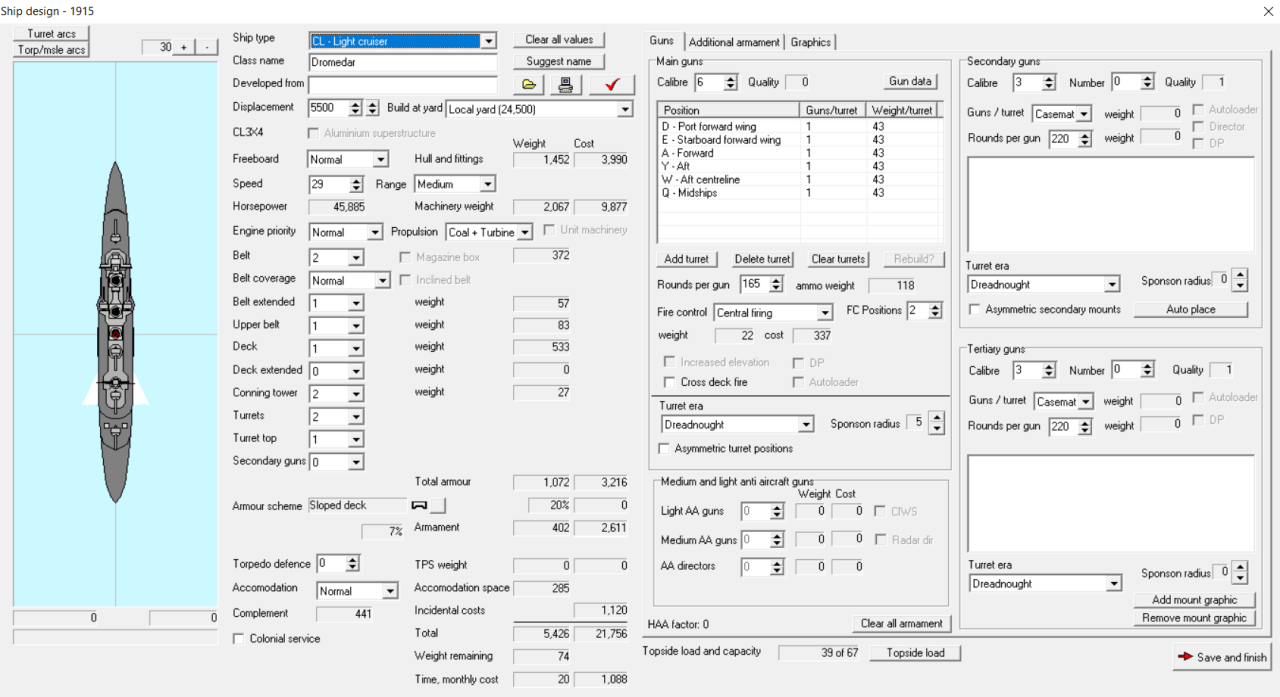 Voila. Here you are. A ship that may not even be a legal design, but now that we’ve got the foundation we can build it up into a real nice ship. First things first- make sure you’re at or below the tonnage limit of the dockyard you selected. This is only really relevant if you’re building a capital ship like a B/BB/BC or CV, since you can’t build a 20,000 ton Super Destroyer with a hundred torpedo mounts and 300 knots speed. Oh well. Use the checkmark button next to the computer button while you’re making a ship. It will determine if the ship design has any problems, and explain what they are.
Voila. Here you are. A ship that may not even be a legal design, but now that we’ve got the foundation we can build it up into a real nice ship. First things first- make sure you’re at or below the tonnage limit of the dockyard you selected. This is only really relevant if you’re building a capital ship like a B/BB/BC or CV, since you can’t build a 20,000 ton Super Destroyer with a hundred torpedo mounts and 300 knots speed. Oh well. Use the checkmark button next to the computer button while you’re making a ship. It will determine if the ship design has any problems, and explain what they are.
Just note that larger doesn’t necessarily mean better- increase the tonnage of the ship if you want to add something, whether a more powerful engine or more ammo capacity. There’s no point paying for an extra 3,000 tons of hull and armor if your ship isn’t using those 3,000 tons for anything. The “Weight Remaining” number is very important- you want it to be positive, but you want to keep it pretty low. Also, DD’s have a weight restriction that can be increased with research. In 1900, some countries have the tech for 500 ton DD’s, but most only have 400 ton DD’s unlocked.
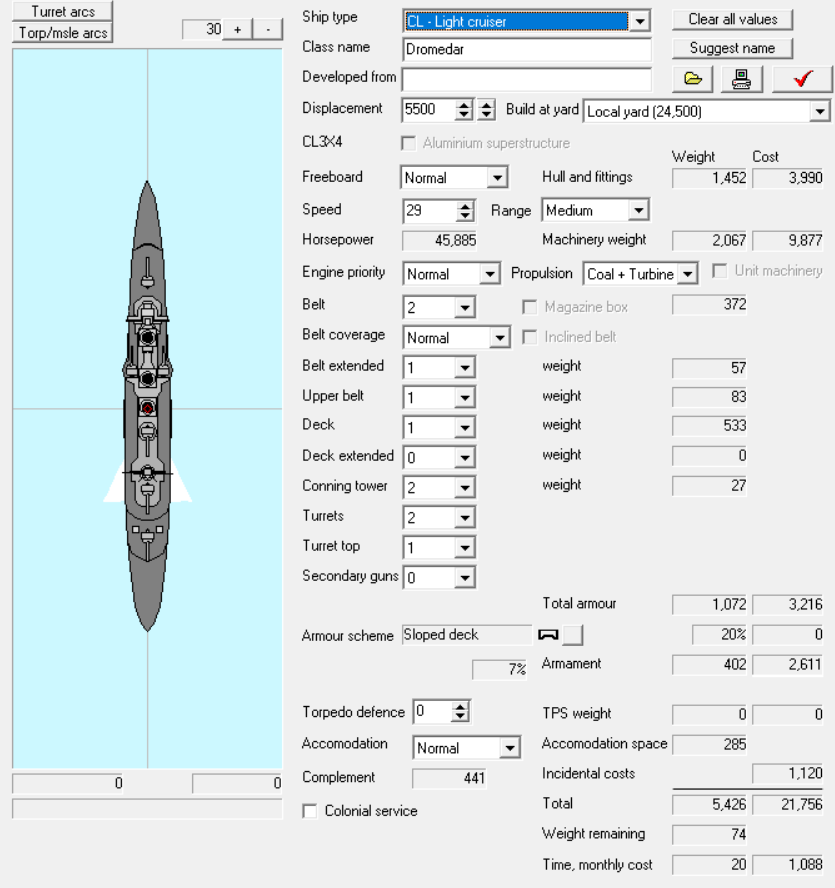 On the left side of the screen, you see a visual portrait of the ship from the top down, along with important design choices for the ship itself. You can hit the “suggest” button next to the class name if you want a historic name for that country from that time, but of course, you can choose your own name by typing into the name box itself. The “developed from” box will tell you what ship you’re developing from, if you rebuild or redevelop an existing ship by right clicking it in the ship list.
On the left side of the screen, you see a visual portrait of the ship from the top down, along with important design choices for the ship itself. You can hit the “suggest” button next to the class name if you want a historic name for that country from that time, but of course, you can choose your own name by typing into the name box itself. The “developed from” box will tell you what ship you’re developing from, if you rebuild or redevelop an existing ship by right clicking it in the ship list.
The engine is critical to the ship. The larger the ship, the more horsepower it will need per knot of max speed. You can optimize the engine of a class to either speed, reliability, or normal. Optimizing for speed means less weight per max knot, but the engine is prone to break down more frequently. Reliability means that the engine will break down less, but needs more weight per max knot. Normal makes no compromises and stands in the middle. As for engine range, Short range ships often have fuel problems and may not show up in a battle they’re supposed to. Long range ships gain effectiveness in attacking trade ships.
When you discover new types of engines, they can be more efficient than existing ones and can give you a leg up over other countries. Oil fired ships are always better than coal ships, both in the decreased weight/financial cost, and you don’t have to worry about coal shovelers getting tired on an oil ship, because there are no coal shovellers of any kind (Coal ships may slow down if kept at max speed for too long as the shovellers get tired, this will appear in the log). Oil ships also produce less smoke than coal,
Next, you have the freeboard, armor belt, and armoring options. If you set the freeboard to “low”, you can save some weight, but the ship will perform badly in poor weather, and is more prone to flooding. If you set the armor belt to “narrow”, less of the ship is protected by the armor belt, but you save some weight. As for the armor values themselves, they are displayed in inches of thickness. Destroyers are completely unarmored, Cruisers have a minor amount, while Battleships have a ton. Most shots that hit your ship will hit the side- the Belt. Some may hit the turrets themselves, or the conning tower (CT). However, if the enemy ship firing on you is very close, or a plane is dropping gravity bombs directly on top of you, then it will hit the deck armor or turret tops. The Armor Scheme is the layout of the armor on the ship, you can change this after you research the required technology if you want.
Torpedo defence systems (TDS) are below, with 0 representing none, 1 and above indicates increasing levels of protection built into the ship to counteract a torpedo hit. It works best on capital ships. Accomodation determines the quality of the crew quarters: Cramped quarters ships will suffer a penalty to morale and crew training when outside of your home region. Colonial Service ticked ships recieve a bonus to “tonnage on foreign stations”.
Finally, at the very bottom, you have the total costs in both weight and money, aswell as the time to build, and monthly cost. Again, keep your weight remaining positive, but as low as you can. Space on a ship should either be used or cut off.
CH 5: Ship Designer, Weapons

The primary guns are the most important on your ship, and every ship (even aircraft carriers) are required to have at least one, maybe more depending on the ship’s role. For primary guns, you have to hit “add turret” and then select a position on the ship to add the turret. A turret that is “Port” or “Starboard” cannot fire on the opposite side of the ship, unless special requirements are met and you check “cross deck fire” (Hit the check mark frequently when you’re dealing with the guns- you may not have the technology for something you think you have, and certain combinations of turrets are not possible). Select the amount of rounds per gun that you want- smaller guns fire faster. You can click “GUN DATA” to see the statistics of a gun of the inches you select.
Choose the fire control option. More advanced fire control means more accurate fire. If a fire control position on your ship is hit, then your guns may lose significant accuracy, unless you have 2 or 3, in which case all of them will have to be hit to suffer the accuracy loss. Increased elevation turrets have an easier time shooting, dual purpose turrets have shells that can fire at both ships and aircraft (only DD’s may have primary DP guns, ships like BB’s can only have them as secondary/tertiary). Autoloaders increase loading speed.
The “Turret Era”, “Sponson Radius”, and “Assymetric turret” are all purely cosmetic options that affects the graphical portrayal of the ship. Change them if you want to.
Secondary turrets are, well, secondary to your main guns. They are of a smaller caliber, have less fire control, and are placed by the ship designer. Note that whenever you computer generate a ship and reduce the amount of secondary guns, it may remove 2 guns on 1 side, instead of 1 gun from each side- fix this by reducing the guns to 0, then reupping it to whatever amount you had in mind. Hit “Auto Place” for the designer to automatically find a place to put the guns visually. Casemates have no armor.
Tertiary turrets are only really used on the biggest of Battleships, and have even fewer options. They have no armor at all, and are smaller in caliber than your secondaries. You cannot have tertiaries without secondaries.
Now, click “additional armament” on top of the right. Here we have all the other weaponry that a ship may carry.
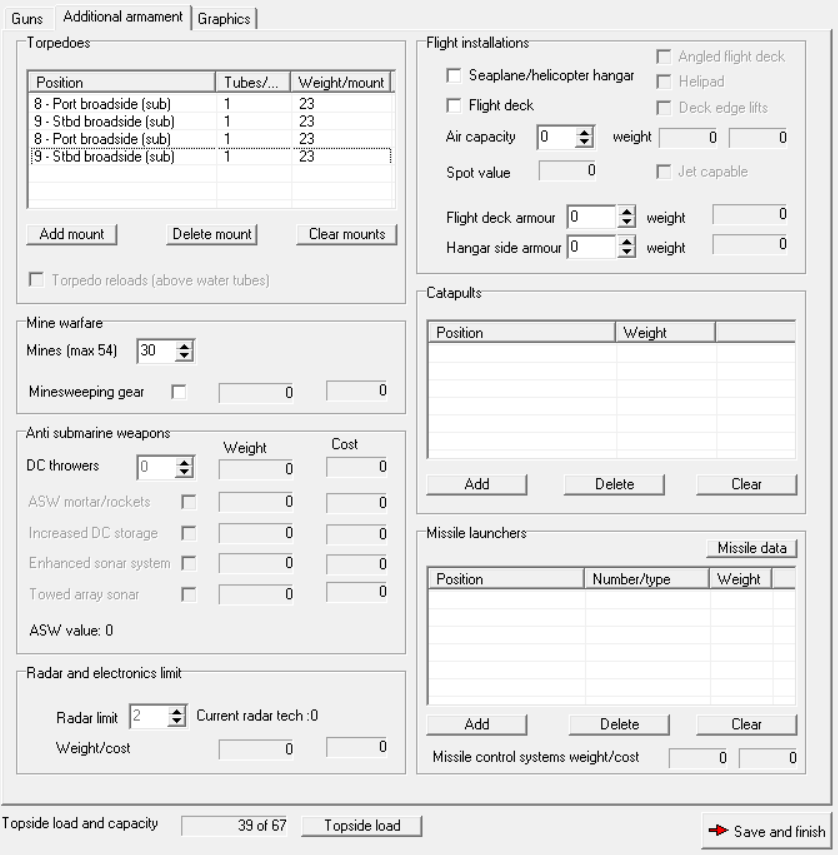 At first, only DD’s may carry torpedos in above-water swivel mounts, and are restricted to 1 tube a mount. As research progresses, you may unlock CL abovewater racks, more than 1 tube a rack, and even reloading your torpedos in combat.
At first, only DD’s may carry torpedos in above-water swivel mounts, and are restricted to 1 tube a mount. As research progresses, you may unlock CL abovewater racks, more than 1 tube a rack, and even reloading your torpedos in combat.
Ships with mines will contribute to creation of minefields in/around your ports. Naval mining will slowly increase as a war goes on but do so faster the more naval mine ships you have. ASW weapons are employed on light forces and increase the capabilities of attacking enemy submarines. Radar, once unlocked, can be added to existing ships using the right click in list –> redesign up to level 2, but 3 or above must be built into the ship, not afterwards as a rebuild.
Flight installations and plane capacity are used for carriers, or large non-carrier ships to carry a deployable floatplane scout or ASW helicopter squadron. Unless you have a catapult, the boat will have to stop to launch any aerial vehicles, carrier or not. Any carriers must be built jet-capable to carry jet powered aircraft.
Missile launchers are for AShM’s (anti ship missiles) and SAM’s (surface to air missiles). AShM’s are generally pretty low weight and can be tacked on as a bonus to any ship, but SAMs require a significant amount of weight.
Finally, the topside load at the very bottom determines how much you can fit onto the top of your ship. If you’ve got too much stuff on top, whether it’s turrets, torpedo racks, anti aircraft guns, helipads, etc, you may suffer a ROF penalty, or even not be able to build the ship at all.
CH 6: Aviation
Zeppelin are based in land bases. Go to “Build Fort”, then build a zeppelin airbase in the region and port you want. Zeppelin will automatically fan out in a circular radius at the start of a battle and scout on their own, they cannot be controlled.
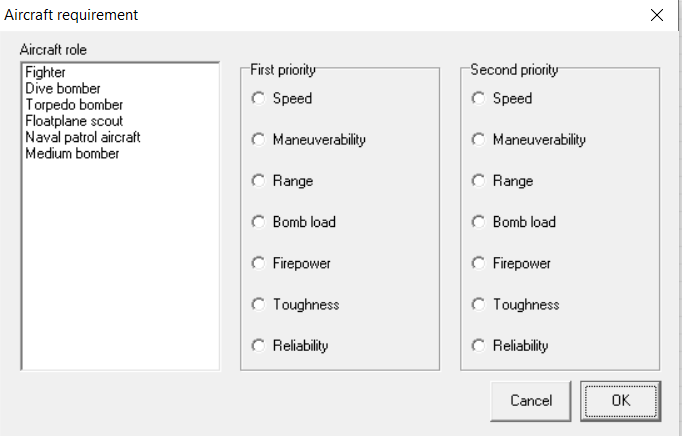 Planes, however, are different. Once discovered, you can begin to request planes from manufacturers. When you request a plane, you must choose the role, and then the two priorities in building it. At first you may only have floatplane scouts, but as time progresses you will research more, and then even carrier capable or jet powered ones.
Planes, however, are different. Once discovered, you can begin to request planes from manufacturers. When you request a plane, you must choose the role, and then the two priorities in building it. At first you may only have floatplane scouts, but as time progresses you will research more, and then even carrier capable or jet powered ones.
 After some months pass, the development of prototypes are complete. Shown on the bottom is your current plane in service, and then a few competing prototypes above. Choose the one that you think best fits the role. Planes will then be automatically manufactured over time and fill up squadrons with the improved planes. Like with ships, stagger your requests for development across roles. There’s no point in updating the fighter aircraft every six months, so develop a fighter, then a medium bomber, then a floatplane scout, then a torpedo bomber, then loop back around to fighter. Again, the order is irrelevant, as long as you stagger development of each role.
After some months pass, the development of prototypes are complete. Shown on the bottom is your current plane in service, and then a few competing prototypes above. Choose the one that you think best fits the role. Planes will then be automatically manufactured over time and fill up squadrons with the improved planes. Like with ships, stagger your requests for development across roles. There’s no point in updating the fighter aircraft every six months, so develop a fighter, then a medium bomber, then a floatplane scout, then a torpedo bomber, then loop back around to fighter. Again, the order is irrelevant, as long as you stagger development of each role.
CH 7: Glossary
B: Pre-dreadnought battleship
Characterized by poor armor, speed, weaponry, or a combination of them all. Capital ship from 1890-1905. Large secondary or even tertiary batteries.
BB: Dreadnought battleship
1905-onwards. Significantly improved battleships- they feature a focus on large, primary guns, with reduced secondary and tertiary guns. The large guns cannot be effectively used at night because of the difficulty in spotting.
BC: Battlecruiser
1905-onwards. Battleships with a special focus on speed at the sacrifice of armor or other aspects. The large guns cannot be effectively used at night because of the difficulty in spotting.
AV: Seaplane carrier
Carries a small complement of floatplanes for scouting missions.
CVL: Light carrier
Carries a small number of carrier-capable planes, fighters, torpedo bombers, whatever it may be.
CV: Carrier
Carries a larger number of carrier-capable planes, fighters, torpedo bombers, whatever it may be.
CL: Light Cruiser
Medium sized ships that form effective screens, no especially heavy armor or especially powerful guns but can have high speed.
AC: Armored Cruiser (later Heavy Cruiser)
Between a cruiser and a battleship, they’ve got a lot more weight in armor and guns but less speed.
DD: Destroyer
Small ship useful for scouting or screening (once unlocked). Powerful in great numbers, and especially effective at night as bigger ship cannons don’t have the range advantage.
SS: Submarine
Ship designed to submerge that carries torpedos as its main weapon. Can be used for fleet support or trade interdiction.
Plane roles and their tasks:
Carrier AND Land capable:
F: Fighter
Shoots down enemy planes. Significantly more effective than shipboard AA cannons if up to date.
TB: Torpedo bomber
Launches torpedos at enemy ships. Attacks will hit belt armor.
DB: Dive bomber
Goes on a steep dive bombing run, proving highly accurate but highly dangerous. Hits deck armor.
FS: Floatplane scout
Effective scout planes that carry little armament
Land airbase only:
MB: Medium bomber
Heavier bomb load than dive bomber, and attacks from higher up. Less danger but less accuracy. Can carry AShM’s when unlocked.
PB: Naval patrol
Effective scout planes that carry little armament, but can use AShM’s when unlocked.
Jet Powered:
LJF: Light jet fighter
Short range but powerful fighter craft. Can be used on carriers without jet-capability but count as 1.5 each for capacity
HJF: Heavy jet fighter
Long range, all weather powerful fighter craft. Requires jet-capable carrier. Can be used on carriers less than 40,000 tons but count 1.5 each for capacity
JA: Jet attack
Far superior AShM capability over other jets. Requires jet-capable carrier. Can be used on carriers less than 40,000 tons but count 1.5 each for capacity
H: Helicopter
Not bad at scouting, but excellent for ASW capability.
Thanks to Derp for his excellent guide, all credits belong to his effort. if this guide helps you, please support and rate it via Steam Community. enjoy the game.

